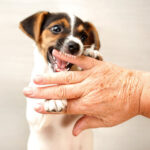What Are Burrs On Dog’s
Understanding Burrs on Dogs: Causes, Effects, and Removal Tips
If you’ve ever taken your dog for a walk in the woods or fields, you may have noticed some tiny, prickly objects sticking to their fur. These objects are called burrs, and they can be annoying, painful, and even dangerous for your furry friend. In this article, we’ll explore what burrs are, why dogs get them, how they can affect their health and behavior, and how you can remove them safely and effectively.
What Are Burrs on Dogs?
Burrs are small seed pods that cling to animal fur with hooks or barbs. They are often found in plants such as burdock, cocklebur, foxtail, and sticktight. Burrs can vary in size, shape, color, and texture depending on the plant species and stage of development. Some burrs are soft and fuzzy, while others are hard and spiky. Some burrs contain toxic chemicals that can irritate or harm dogs if ingested or absorbed through the skin.
Why Do Dogs Get Burrs?
Dogs get burrs mainly by brushing against or stepping on plants that produce them. Some dogs are more prone to get burrs than others due to their coat type, activity level, and habitat. For example, long-haired breeds like collies and shih tzus may attract more burrs than short-haired breeds like greyhounds and boxers. Active dogs who like to roam outdoors may encounter more burr-bearing plants than homebodies who stay indoors most of the time. Dogs who live in rural areas with lots of wild vegetation may face more burr challenges than those who live in urban or suburban areas with less greenery.
What Are the Effects of Burrs on Dogs?
The effects of burrs on dogs depend on various factors such as the type and amount of burrs, the location and duration of attachment, and the dog’s size, age, and health. Some common effects of burrs on dogs include:
– Physical discomfort: Burrs can cause pain, itching, inflammation, and infection on the skin, eyes, ears, nose, mouth, or genitals of dogs. They can also tangle or mat hair, making it harder to groom or cool down.
– Behavioral changes: Burrs can make dogs more anxious, fearful, aggressive, or clingy due to the discomfort they feel. They may also become more distracted or reactive to stimuli in their environment as they try to remove or avoid burrs.
– Medical complications: Burrs can lead to various medical complications if not removed properly and promptly. For example, burrs that enter the eyes can cause corneal ulcers or blindness. Burrs that enter the ears can cause infections or hearing loss. Burrs that enter the nose or mouth can cause respiratory distress or choking. Burrs that penetrate the skin can cause abscesses or sepsis.
How Can You Remove Burrs from Dogs?
Removing burrs from dogs requires patience, gentleness, and some basic tools such as gloves, scissors, tweezers, and a comb. Here are some general steps you can follow to remove burrs safely and effectively:
1. Assess the situation: Check your dog’s entire body for any visible burrs and assess their severity and location. If there are only a few burrs on the surface of the fur, you may be able to remove them easily with your fingers or a comb. If there are many burrs deeply embedded in the skin or mucous membranes, you may need to seek professional help from a veterinarian or groomer.
2. Prepare the tools: Wear gloves to protect your hands from sharp edges or toxic substances in some burrs. Use scissors to cut off as much hair around the burr as possible without cutting the skin. Use tweezers or pliers to grip the burr as close to the base as possible and pull it out gently and steadily in the direction of growth. Avoid twisting or yanking the burr, as this can cause more pain or damage.
3. Check for residue: After removing the burr, check for any remaining fragments or debris that may still be stuck to the fur or skin. Use a comb or brush to untangle any matted hair and remove any loose particles. Use warm water and mild soap to wash the affected areas if necessary, but avoid getting water or soap into the eyes, ears, nose, or mouth.
4. Soothe the dog: After removing all burrs and cleaning up, soothe your dog with praise, treats, or playtime to reinforce positive behavior and reduce stress. Monitor your dog’s behavior and health for any signs of complications such as swelling, redness, discharge, lethargy, or loss of appetite.
In conclusion, burrs on dogs can be a nuisance at best and a hazard at worst. By understanding what burrs are, why dogs get them, how they can affect their health and behavior, and how you can remove them safely and effectively, you can help your furry friend stay happy and healthy despite nature’s challenges. Remember to always be gentle, patient, and prepared when dealing with burrs on dogs!



